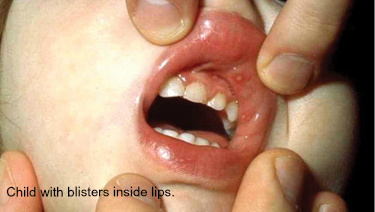By: Sabiha R. Hussain, MD, FAAP
Hand, foot and mouth disease (HFMD) is a common viral illness in young children that typically spreads in summer and fall.
Here's what to know about hand, foot and mouth disease, including key symptoms, how it spreads and ways to help a child cope with the discomfort it causes. Also learn when a child with hand, food and mouth disease can safely return to child care or school.
What is hand, foot and mouth disease?
Hand, foot and mouth disease is caused by different viruses. It typically affects infants and children under 5 years old, but older kids and adults can catch it as well. It is highly contagious. Despite its scary name, though, hand, food and mouth disease is generally mild.
What are the signs and symptoms of hand, food and mouth disease?
From the time a child is first exposed to hand, foot and mouth disease, it can take 3 to 6 days for the first symptoms to show up.
Cold-like symptoms, followed by rash
 Symptoms of hand, food and mouth disease usually start with a
fever,
sore throat, and runny nose—much like the
common cold. But then a rash with tiny blisters may start to show up on the following parts of the body:
Symptoms of hand, food and mouth disease usually start with a
fever,
sore throat, and runny nose—much like the
common cold. But then a rash with tiny blisters may start to show up on the following parts of the body:
Note: Just one, a few or all of these body sites may have blisters.
How long do symptoms last?
Symptoms are the worst in the first few days but are usually completely gone within a week. Some kids have peeling on their fingers and toes 1 to 2 weeks later, but it is harmless.
How is hand, foot and mouth disease diagnosed?
Your pediatrician can tell if your child has hand, foot and mouth disease based on the symptoms you describe and by looking at your child's mouth sores and rash.
Depending on how severe your child's symptoms are, the doctor may collect samples from your child's throat and send them to a lab for testing.
If your child is diagnosed with hand, foot and mouth disease, make sure you let your child's school or child care provider know. They may need to inform other parents and staff members about watching for symptoms.
How is hand, foot and mouth disease treated?
There isn't any medicine to treat or cure hand, foot and mouth disease. The only thing parents can do is ease the fever and pain with
acetaminophen or
ibuprofen.
Call your pediatrician if your child's fever lasts more than 3 days or if they are not drinking fluids.
For mouth pain:
In children over age 1 year, parents can consult with their doctor. There are several liquid mouth-soothing remedies that may help with mouth ulcer pain. Do not use regular mouth washes, because they sting.
Age 1 to 6 years: Put a few drops in your child's mouth or put it on with a cotton swab.
Age over 6 years: Use 1 teaspoon (5 mL) as a mouth wash. Keep it on the mouth blisters as long as possible. Then have your child spit it out or swallow it.
Avoid dehydration:
Children with hand, foot and mouth disease need to drink plenty of fluids. Call your pediatrician now or go to the ER if you suspect your child is dehydrated.
See Signs of Dehydration in Infants & Children for more information.
How long is hand, food and mouth disease contagious?
It is generally most contagious during the first week of illness. But children with hand, foot and mouth disease may shed the virus from the respiratory tract (nose, mouth and lungs) for 1 to 3 weeks. The virus can also be present in the stool for weeks to months after the infection starts.
How is hand, foot and mouth disease spread?
The virus causing hand, foot and mouth disease is usually spread through person-to-person contact in different ways:
Respiratory route:
Contact with large droplets that form when a child talks, coughs or sneezes. These droplets can land on or be rubbed into the eyes, nose or mouth. The droplets tend not to stay in the air; usually, they travel no more than 3 feet and fall onto the ground.
Contact with the respiratory secretions (nasal mucus or saliva) from objects contaminated by children who carry these viruses.
Fecal-oral route:
Contact with stool of children who are infected. This generally involves a sick child dirtying their own fingers and then touching an object that another child touches. The child who touched the contaminated surface then puts their fingers into their own mouth or another person's mouth.
How to prevent and control the spread of hand, foot, and mouth disease
Teach your children to cover their mouths and noses when sneezing or coughing with a disposable tissue, if possible. If they aren't able to get a tissue in time, teach them to use their upper arm sleeve or elbow.
Teach everyone to
wash their hands right after using tissues or having contact with mucus. Change or cover clothing with mucus on it.
Dispose of tissues that contain nasal mucus after each use.
Wash your hands after changing diapers. Parents can spread the virus to other surfaces by coming in contact with any feces, blister fluid or saliva.
Clean, rinse, and sanitize all of your chlid's toys.
Prevent sharing of food, drinks and personal items that may touch your child's mouth, such as eating utensils, toothbrushes and towels.
Protect other children in the house. Make sure they do not come in close contact with the child who is infected. Kissing, hugging and sharing cups and utensils can spread the infection quickly. If your children share a room, separate them until your child feels better and their blisters have healed.
Disinfect any surfaces your child touches frequently. This may be helpful to prevent a sibling from getting hand, foot and mouth disease (and it is doable if you're careful about cleaning surfaces).
Can my child go to school or child care with hand, foot and mouth disease?
Yes, except for when:
The child is not feeling well enough to participate in class or has a fever.
The teacher or child care provider feels they cannot take care of the child without compromising care for the other children in the class. Excessive drooling from mouth sores might be a problem that people find difficult to manage.
The child has many open blisters. It usually takes about 7 days for the blisters to dry up.
The child meets other exclusion criteria.
In some cases, the local health department may require children with hand-foot-and-mouth disease to stay home to control an outbreak.
When can my child go back to school or child care?
A child can return to school or child care after all of the exclusion criteria
(listed above) are resolved and the child feels well enough to participate. Talk with your child's pediatrician if you are not sure when your child should return to school or child care.
If my child has already had hand, foot and mouth disease can they get it again?
Yes. A child can have repeat infections with the same type of virus or different viruses that cause hand, foot and mouth disease.
More resources
About Dr. Hussain Sabiha R. Hussain, MD, FAAP, is a board-certified pediatrician and current pediatric infectious diseases fellow at Baylor College of Medicine/Texas Children's Hospital. Within the American Academy of Pediatrics, she is a member of the education sub-committee for the section on infectious diseases. Sabiha R. Hussain, MD, FAAP, is a board-certified pediatrician and current pediatric infectious diseases fellow at Baylor College of Medicine/Texas Children's Hospital. Within the American Academy of Pediatrics, she is a member of the education sub-committee for the section on infectious diseases.
|